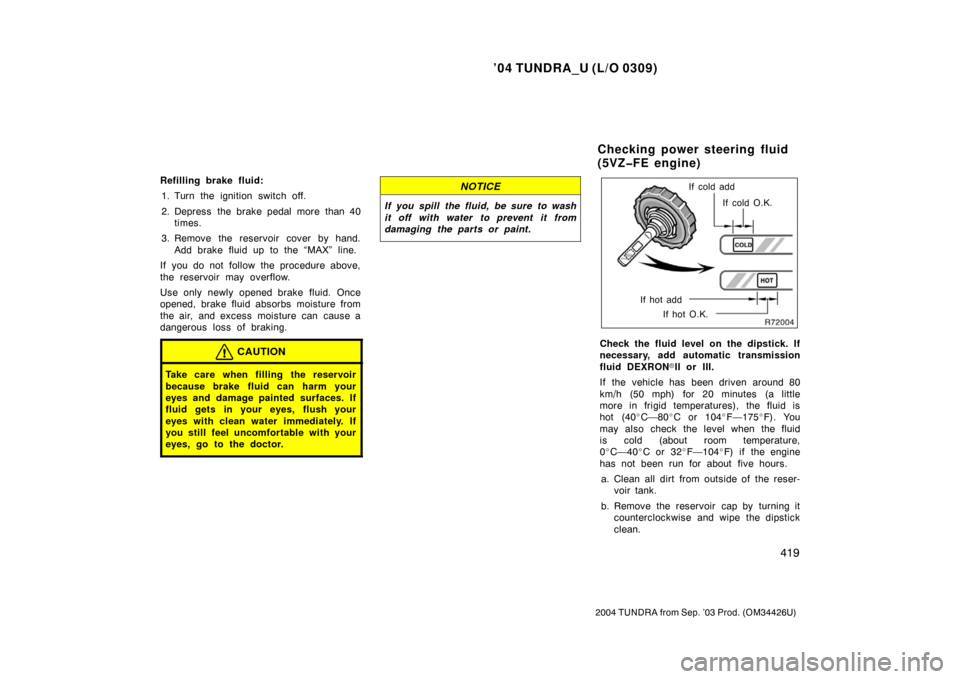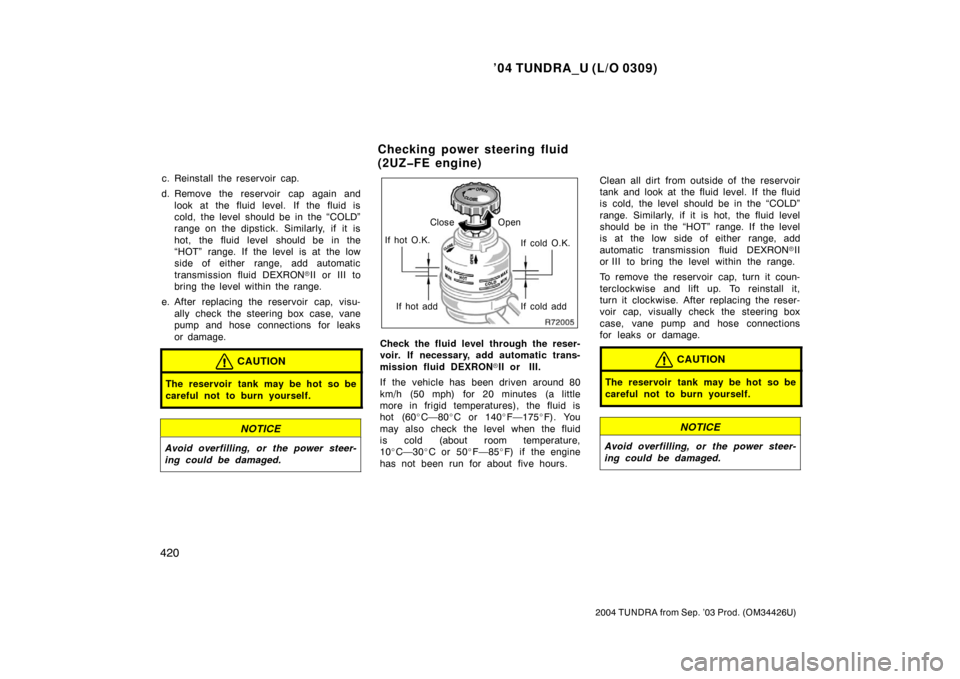Page 428 of 479

’04 TUNDRA_U (L/O 0309)
419
2004 TUNDRA from Sep. ’03 Prod. (OM34426U)
Refilling brake fluid:
1. Turn the ignition switch off.
2. Depress the brake pedal more than 40 times.
3. Remove the reservoir cover by hand. Add brake fluid up to the “MAX” line.
If you do not follow the procedure above,
the reservoir may overflow.
Use only newly opened brake fluid. Once
opened, brake fluid absorbs moisture from
the air, and excess moisture can cause a
dangerous loss of braking.
CAUTION
Take care when filling the r eservoir
because brake fluid can harm your
eyes and damage painted surfaces. If
fluid gets in your eyes, flush your
eyes with clean water immediately. If
you still feel uncomfortable with your
eyes, go to the doctor.
NOTICE
If you spill the fluid, be sure to wash
it off with water to prevent it from
damaging the parts or paint.
If cold add
If cold O.K.
If hot add If hot O.K.
Check the fluid level on the dipstick. If
necessary, add automatic transmission
fluid DEXRON �II or III.
If the vehicle has been driven around 80
km/h (50 mph) for 20 minutes (a little
more in frigid temperatures), the fluid is
hot (40 �C—80 �C or 104 �F—175 �F). You
may also check the level when the fluid
is cold (about room temperature,
0 �C—40 �C or 32 �F—104 �F) if the engine
has not been run for about five hours.
a. Clean all dirt from outside of the reser- voir tank.
b. Remove the reservoir cap by turning it counterclockwise and wipe the dipstick
clean.
Checking power steering fluid
(5VZ�FE engine)
Page 429 of 479

’04 TUNDRA_U (L/O 0309)
420
2004 TUNDRA from Sep. ’03 Prod. (OM34426U)
c. Reinstall the reservoir cap.
d. Remove the reservoir cap again and look at the fluid level. If the fluid is
cold, the level should be in the “COLD”
range on the dipstick. Similarly, if it is
hot, the fluid level should be in the
“HOT” range. If the level is at the low
side of either range, add automatic
transmission fluid DEXRON �II or III to
bring the level within the range.
e. After replacing the reservoir cap, visu- ally check the steering box case, vane
pump and hose connections for leaks
or damage.
CAUTION
The reservoir tank may be hot so be
careful not to burn yourself.
NOTICE
Avoid overfilling, or the power steer-
ing could be damaged.
If hot O.K. Close Open
If cold O.K.
If hot add If cold add
Check the fluid level through the reser-
voir. If necessary, add automatic trans-
mission fluid DEXRON �II or III.
If the vehicle has been driven around 80
km/h (50 mph) for 20 minutes (a little
more in frigid temperatures), the fluid is
hot (60 �C—80 �C or 140 �F—175 �F). You
may also check the level when the fluid
is cold (about room temperature,
10 �C—30 �C or 50 �F—85 �F) if the engine
has not been run for about five hours. Clean all dirt from outside of the reservoir
tank and look at the fluid level. If the fluid
is cold, the level should be in the “COLD”
range. Similarly, if it is hot, the fluid level
should be in the “HOT” range. If the level
is at the low side of either range, add
automatic transmission fluid DEXRON
�II
or III to bring the level within the range.
To remove the reservoir cap, turn it coun-
terclockwise and lift up. To reinstall it,
turn it clockwise. After replacing the reser-
voir cap, visually check the steering box
case, vane pump and hose connections
for leaks or damage.
CAUTION
The reservoir tank may be hot so be
careful not to burn yourself.
NOTICE
Avoid overfilling, or the power steer-
ing could be damaged.
Checking power steering fluid
(2UZ�FE engine)
Page 458 of 479

’04 TUNDRA_U (L/O 0309)
449
2004 TUNDRA from Sep. ’03 Prod. (OM34426U)
Model:
5VZ− FE and 2UZ −FE
Type: 5VZ− FE engine
6 cylinder V type, 4 cycle, gasoline
2UZ− FE engine
8 cylinder V type, 4 cycle, gasoline
Bore and stroke, mm (in.): 5VZ− FE engine
93.5 �82.0 (3.68 �3.23)
2UZ− FE engine
94.0 �84.0 (3.70 �3.31)
Displacement, cm
3 (cu. in.):
5VZ− FE engine 3378 (206.1)
2UZ− FE engine 4664 (284.6)Fuel type:
Unleaded gasoline, Octane Rating 87
(Research Octane Number 91) or higher
Fuel tank capacity, L (gal., Imp. gal.): 100 (26.4, 22.0) ENGINE
Valve clearance (engine cold), mm (in.):
5VZ− FE engine
Intake 0.13—0.23 (0.006—0.009)
Exhaust 0.27—0.37 (0.011—0.014)
2UZ− FE engine
Intake 0.15—0.25 (0.006—0.010)
Exhaust 0.25—0.35 (0.010—0.014)
Spark plug type: 5VZ− FE engine
DENSO K16TR11
NGK BKR5EKB11
2UZ− FE engine
DENSO K20R−U
NGK BKR6EYA
Spark plug gap, mm (in.): 5VZ− FE engine 1.1 (0.043)
2UZ− FE engine 0.8 (0.031)
Drive belt tension measured with Bor-
roughs drive belt tension gauge
No. BT− 33−73F (used belt), lbf:
5VZ− FE engine
Generator belt 100� 20
Air conditioning compressor belt 100� 20
Power steering pump belt
100
+20
�15
Engine FuelService specifications
Page 461 of 479

’04 TUNDRA_U (L/O 0309)
452
2004 TUNDRA from Sep. ’03 Prod. (OM34426U)
Recommended oil viscosity:
FrontSAE 75W −90
Rear Standard differential
Synthetic oil SAE 75W −140
Limited− slip differential
Above −18 �C (0 �F)
SAE 90
Below −18 �C (0 �F)
SAE 80W or 80W −90
CHASSIS LUBRICATION
Propeller shafts: SpidersLithium base chassis grease, NLGI
No.2
Double cardan joint Molybdenum −disulfide lithium base
chassis grease, NLGI No.2
Slide yokes Lithium base chassis grease, NLGI
No.2 or Molybdenum −disulfide lithium
base chassis grease, NLGI No.2 BRAKES
Minimum pedal clearance when depressed
with the force of 490 N (50 kgf, 110 lbf)
with the engine running, mm (in.):
Without vehicle stability control system95 (3.7)
With vehicle stability control system 80 (3.1)
Pedal free play, mm (in.): 1—6 (0.04—0.24)
Pad wear limit, mm (in.): 1.0 (0.04)
Lining wear limit, mm (in.): 1.0 (0.04)
Parking brake adjustment: Pedal type—when depressed with the
force of 294 N (30 kgf, 66.1 lbf)8—10 clicks
Lever type—when pulled with the force
of 196 N (20 kgf, 44 lbf) 8—12 clicks
Fluid type: SAE J1703 or FMVSS No.116 DOT 3 STEERING
Wheel free play:
Less than 30 mm (1.2 in.)
Power steering fluid type: Automatic transmission fluid DEXRON �II
or III